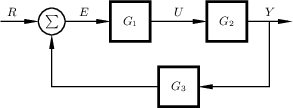
Note the difference in structure between this file and the previous one, feedback0.tex. In this case the various \tikzset{... commands are positioned before the \begin{document} statement. This is to demonstrate that these commands might also be placed in a document-wide .sty file, that is included in all tikz-figures belonging to the document, as well as the main document itself.
All subsequent figures will have this structure.
\documentclass{standalone}
\usepackage{tikz}
\usetikzlibrary{shapes,positioning}
\usetikzlibrary{narrow}
\tikzset{block/.style={draw, rectangle, line width=2pt,
minimum height=3em, minimum width=3em, outer sep=0pt}}
\tikzset{sumcircle/.style={draw, circle, outer sep=0pt,
label=center:{{$\sum$}}, minimum width=2em}}
\tikzset{every picture/.style={auto, line width=1pt,
>=narrow,font=\small}}
\begin{document}
\begin{tikzpicture}
\node[block](G1){$G_1$};
\node[block,right=15mm of G1](G2){$G_2$};
\draw[->](G1)--node[above](U){$U$}(G2);
\node[block,below=12mm of U](G3){$G_3$};
\node[sumcircle,left=12mm of G1](sum){};
\node[coordinate, left=10mm of sum](ref){};
\draw[->](ref)--node[xshift=-2mm](){$R$}(sum);
\draw[->](sum)--node[xshift=-1mm](){$E$}(G1);
\node[coordinate, right=12mm of G2](output){};
\draw[->](G2)--node[xshift=0mm](Y){$Y$}(output);
\draw[->](Y)|-(G3);
\draw[->](G3)-|(sum);
\end{tikzpicture}
\end{document}
